- EraMedieval/Islamic
- Project DirectorDr. Nicholas Warner
- LocationCairo
- AffiliationARCE
- Project SponsorARCE
- Project Dates:2022-2024
Written by: Sally El Sabbahy and Nicholas Warner

Trainees visit the site in March 2022 as part of an advanced training on photogrammetric documentation organized by ARCE. PC: Sally El Sabbahy
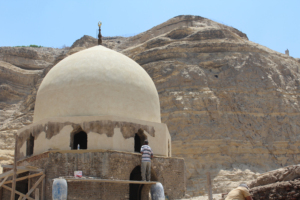
The dome during external repair works in June 2022. PC: Sally El Sabbahy
Nestled in the eastern hillside of the Mokattam escarpment, about 15 minutes’ drive from the Cairo Citadel, is the Shrine of Ikhwat Yusuf (‘Brothers of Joseph’). This rare survival from the Fatimid period was constructed at some point in the early 12th century in the southernmost extension of Cairo’s historic City of the Dead. The shrine is comprised of a domed mausoleum that is approached through two adjacent prayer rooms. The mausoleum still retains its original ‘triple’ mihrab (prayer niche) framed by carved stucco decoration with geometric motifs and inscriptions in an elaborate floriated Kufic – a particularly popular form during the Fatimid Caliphate (AD 909-1171). Since 1991 the monument has seen several interventions aimed at consolidating at risk architectural elements, such as its dome, and clearing debris and rubble from its interior. Despite these efforts by the Supreme Council of Antiquities (SCA), the condition of the shrine continued to deteriorate in its physical integrity and appearance. This was manifest in the loss of external plaster and window grilles, major structural cracks, and the collapse of a limestone roof vault.
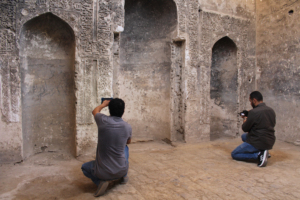
Osama Dawod of Factum Arte and Mohab Abd ElMegid of the Ministry of Tourism and Antiquities do follow-up photogrammetry on the mihrab in July 2022. PC: Sally El Sabbahy
After applying to the SCA for permission to conserve the monument in 2021, ARCE was granted approval to carry out work beginning in 2022 with an anticipated completion of the project in mid-2024. The first year of work in 2022 consisted of interventions that focused on the clearance of accumulated debris from in and around the Shrine, physical conservation of masonry, digital documentation of the entire monument and its stucco mihrab by CPT Studio and Factum Arte, respectively, and an advanced training course in photogrammetry and 3D modelling for four inspectors from the Ministry of Tourism and Antiquities (MoTA) by Dina Bakhoum and Dr. David Anderson of the University of Wisconsin-La Crosse. Notably, two of the trainees went on to provide invaluable support towards ARCE’s documentation efforts at the Shrine; with Suzan Fathy assisting the project conservator Bianca Madden in the documentation of historic graffiti left by religious visitors inside the monument, and Mohab Abd ElMegid assisting Factum Arte in carrying out follow-up photogrammetric documentation of the mihrab.
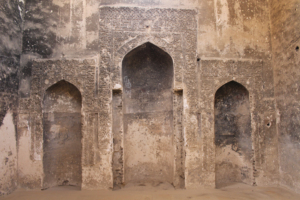
The carved stucco triple mihrab from the Shrine’s central prayer hall, a rare Fatimid survival. PC: Sally El Sabbahy

Details of the mihrab, as captured photogrammetrically by Factum Arte. PC: Factum Arte
During the clearance of debris in 2022, several exciting discoveries were made, including the original lime plaster floor of the shrine, which had miraculously survived under a later layer of limestone paving. Many ceramics were also found during the clearance of the Shrine’s floor and roof shedding light on the later, Mamluk, extension of the complex. These have been securely stored and will be catalogued and inventoried at a later stage in the project. Other significant findings from the clearance of the monument’s interior included three anonymous crypts that probably contained multiple burials of individuals who wished to be interred in this important religious site and a freshwater cistern, supplied by water carriers from the Nile, in one of the secondary prayer hall. The clearance works also aided in the substantial physical improvements that took place in 2022, which included external and internal masonry, consolidation, the stabilization and restoration of the collapsed North wall, repairs to the South wall and the roof, replacing/rebuilding door jambs where necessary, and external plastering of the dome and repairs to its wood and brass finial.

Skilled repairs to the cistern in July 2023. PC: Sally El Sabbahy

The cistern after full restoration in August 2023. PC: Sally El Sabbahy
Given the amount of structural work executed at the site, material selection was critical. While much of the monument was constructed from Fatimid brickwork, there were also later additions and repairs made during the late Mamluk period that employed different materials and workmanship. Accordingly, specially made bricks that matched the size of the original Fatimid bricks were sourced in Minya and utilized to fill in and repair any losses of brick masonry throughout the Fatimid portions of the monument. Similarly, repairs made to the later additions of the monument relied on the use of larger, saw-cut limestone blocks.

Consolidation and waterproofing of the roof in July 2023. PC: Sally El Sabbahy

An interior shot of the completed vaulted roof, restored after its past collapse. PC: Sally El Sabbahy
The most recent season of work in the summer of 2023 built directly on the improvements made in 2022. A missing section of roof over the cistern was outfitted with a wooden malqaf or wind scoop, facing north, to provide natural lighting and ventilation to the interior. New limestone paving was also laid throughout the interior of the Shrine, save for the areas of original flooring which were left intact and visible. The collapsed vault was also fully restored with a limestone groin vault, without the use of a supporting timber frame – a major engineering feat of the 2023 season! The roof was then outfitted with waterproofed sheeting and sealed with limestone paving set over sand insulation. For security reasons, a protective enclosure wall was also constructed to the south of the Shrine, eliminating any unwarranted access to the roof and dome of the monument.
In May and June 2024, ARCE returned to the Shrine of Ikhwat Yusuf to complete its program of conservation work. This included the clearance of the area immediately to the north of the tomb chamber where the remains of an Ottoman period limestone arcade still stood. The arcade was missing one or its arches, closest to the tomb chamber, and this was rebuilt to match the surviving arches using traditional techniques. Within the shrine, pointing was carried out in selective areas within the two prayer spaces east of the tomb chamber.

Cleaning of one of the stone pendentive domes using poultices in June 2024. PC: Nicholas Warner

Conservator Mark Perry consolidates a broken plaster edge in June 2024. PC: Nicholas Warner
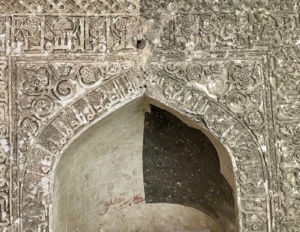
Central niche of the mihrab during conservation in June 2024 showing results of laser cleaning on the left. PC: Nicholas Warner.
Most of the work during the season was focussed, however, on the more delicate tasks of cleaning and consolidating internal plaster surfaces (including the triple mihrab) and removing soot from the stone domes and brick vaults leading to the tomb chamber. This latter process involved the application of numerous poultices of dilute ammonium carbonate. The same technique was employed on the inner surfaces of the surviving plaster of the brick dome led by conservator Abd al Rahman al-Taiyyib. Even more painstaking was the treatment of the plaster at lower levels in the shrine. For this purpose, a portable laser was brought in from Germany by lead conservator Bianca Madden. ‘Cleaning with light’ is a relatively new technology in conservation but it proved extremely effective when treating the fragile and soft cut plaster of the mihrab or the plaster bearing a palimpsest of inscriptions left by the numerous pilgrims who visited the site over centuries. The ability to vary the intensity of the laser’s light beam according to individual conditions allowed for superlative control. Conservators Mohamed Ibrahim and Mark Perry assisted Madden in her task. It was one of the expectations of the project that traces of painted decoration would be found on the triple mihrab, but in the event none was discovered.
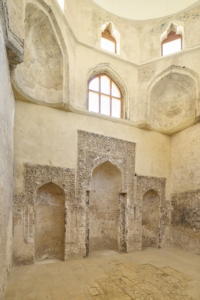
The triple mihrab after final conservation in June 2024. PC: Matjaz Kacicnik
In parallel with the conservation work, Dr. Gillian Pyke carried out a detailed study of the ceramics found on the roof inside the pendentives of the stone domes, as well as in various locations inside and outside the complex. This conclusively proved that the shrine was extended in the Mamluk period, and that it remained a site of regular visitation through the Ottoman period. In addition to unglazed domestic wares, glazed sherds typical to the Mamluk and Ottoman periods were identified, together with a large assemblage of Ottoman pipe bowls.
In 2024, visitor information was designed in collaboration with the Ministry of Tourism and Antiquities’ Site Development Office directed by Dr. Bassem Ibrahim was installed inside a purpose made showcase inside the entrance to the shrine. Complementing this information was a selection of the ceramics discovered during the life of the project. Although there are no immediate plans to open the site to tourists, it is possible that this may happen in the future. In the meantime, curious visitors are welcome to visit and view the shrine from the outside.
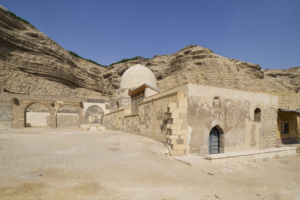
Exterior of the shrine after conservation showing new timber windscoop and restored arch in arcade. PC: Matjaz Kacicnik, 2024

View of the prayer hall leading to the tomb chamber after final conservation in June 2024. PC: Matjaz Kacicnik
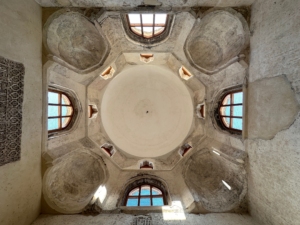
View looking up at the dome after final conservation in June 2024. PC: Nicholas Warner
Project credits:
ARCE: Nicholas Warner, Sally el Sabbahy, Bianca van Sittert
MOTA: Chief Inspector Abdallah Saad, Inspector Ayman Mohamed Abd al-Raziq
Documentation: Pietro Gasparri, Matjaz Kacicnik, Gillian Pyke
Training: David Anderson, Dina Bakhoum
Lead conservators: Bianca Madden, Mark Perry, Mohamed Ibrahim
Construction team: Al-Taiyyib Company for Restoration